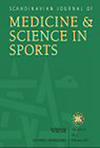Cold Water Immersion Does Not Enhance Recovery and Performance After High‐Intensity Interval Dorsiflexion Exercise
IF 3.8
2区 医学
Q1 SPORT SCIENCES
引用次数: 0
Abstract
Cold‐water immersion (CWI) has become a widely adopted method for post‐exercise recovery. However, its effectiveness in restoring neuromuscular function remains inconclusive. This study examined the impact of CWI on recovery following high‐intensity interval exercise (HIIE). Twelve young, recreationally active individuals (10 males, 2 females) participated in a randomized crossover study. Each session included six sets of 30‐s all‐out isokinetic concentric contractions of the ankle dorsiflexor and plantar flexor muscles, followed by 10 min of room temperature rest (RT) or CWI at 10°C. Neuromuscular function and intramuscular temperature were evaluated periodically over 24 h, as well as next‐day fatigue resistance of the dorsiflexors. In both conditions, maximal voluntary contraction torque remained impaired for up to 3 h without significant changes in voluntary activation (冷水浸泡不能提高高强度间歇背屈运动后的恢复和表现
冷水浸泡(CWI)已成为广泛采用的运动后恢复方法。然而,其在恢复神经肌肉功能方面的有效性仍不确定。本研究考察了CWI对高强度间歇运动(HIIE)后恢复的影响。12名年轻、娱乐活跃的个体(10名男性,2名女性)参加了一项随机交叉研究。每个疗程包括6组30秒的踝关节背屈肌和足底屈肌全等速同心收缩,随后10分钟的室温休息(RT)或10°C的CWI。在24小时内定期评估神经肌肉功能和肌内温度,以及第二天背屈肌的抗疲劳性。在这两种情况下,最大自主收缩扭矩受损长达3小时,而自主激活没有明显变化(p >;0.05)。电刺激扭矩在疲劳引起的10hz扭矩下降或恢复中没有差异,在长达3小时的时间内仍然存在损伤。然而,50hz扭矩在RT后1小时内恢复,而在CWI后3小时内仍略有降低。10:50 Hz扭矩比显示CWI立即恢复,而RT恢复延迟长达1小时。值得注意的是,在干预后0 -、0.5 -和1 - h, RT的扭矩比显著降低。尽管存在这些差异,但在24小时后进行的重复试验中,HIIE的表现仍然相似。综上所述,在10°C下进行10分钟的CWI并不能提高HIIE后的运动后恢复或第二天的运动表现。
本文章由计算机程序翻译,如有差异,请以英文原文为准。
求助全文
约1分钟内获得全文
求助全文
来源期刊
CiteScore
7.90
自引率
4.90%
发文量
162
审稿时长
3 months
期刊介绍:
The Scandinavian Journal of Medicine & Science in Sports is a multidisciplinary journal published 12 times per year under the auspices of the Scandinavian Foundation of Medicine and Science in Sports.
It aims to publish high quality and impactful articles in the fields of orthopaedics, rehabilitation and sports medicine, exercise physiology and biochemistry, biomechanics and motor control, health and disease relating to sport, exercise and physical activity, as well as on the social and behavioural aspects of sport and exercise.

 求助内容:
求助内容: 应助结果提醒方式:
应助结果提醒方式:


